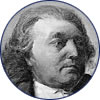Samuel Seabury
1729–1796 B.A. 1749
|

|
S amuel Seabury has been dismissed as “a somewhat pompous, opinionated eccentric with few redeeming qualities.” Worse yet, this Connecticut-born Anglican priest sided with Britain in the American Revolution. Narrowly escaping a lynch mob, he fled to British-occupied New York and served as a guide to General Howe’s Redcoats on Long Island. And yet, just a few years after independence, the reluctant American had become the country’s first Episcopal bishop and would play a crucial role in establishing the American church.
The Church of England in America reached an impasse with the arrival of independence. This socially influential denomination (two-thirds of the signers of the Declaration of Independece were members) had depended on British bishops to ordain its clergy and provide the crucial link to the roots of Christianity (the traditional “apostolic succession”). The American church now needed bishops of its own, but such titles could only be conferred by existing bishopswhich meant those in Britain.
Seabury himself was no doubt surprised to be selected as the first American bishop designate. But he had undeniable qualifications: a clergyman father, Yale education, doctorate from Oxford, and ordination (in 1753) as a priest in England.
Following consecration in Scotland, Seabury returned to Connecticut in 1785 as bishop of Connecticut and, eventually, Rhode Island. By the time of his death, the American Episcopal Church had overcome a near-schism, on its way to becoming a denomination with worldwide representation.

